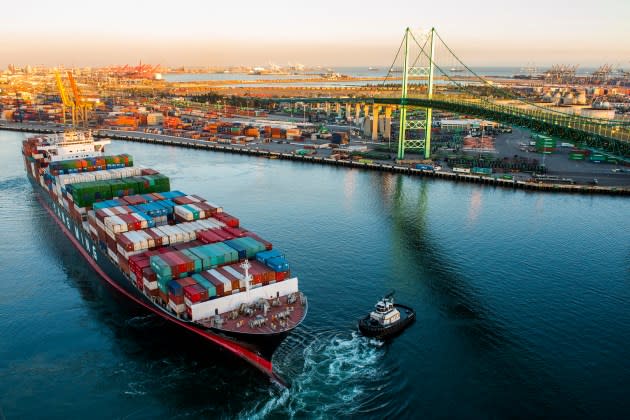Peak Holiday Shipping Season Is Over as Shoppers Bought Earlier and Retailers Imported Sooner

With imports from Asia down dramatically this year and consumers doing their holiday shopping a little earlier, overstuffed warehouses are slimming down to healthier weights.
Overall, cargo container numbers arriving in Southern California’s port complex during the first nine months of the year were down 19 percent compared to last year and much of that is due to a nationwide 18 percent decline in Asian imports. It is also tied to consumers’ shifting demands for goods. Instead of spending money on appliances, furniture and clothing, U.S. shoppers are devoting a larger percentage of their budget to fun things like traveling, eating out or actually taking in a movie like “Barbie.”
More from WWD
EXCLUSIVE: F1 Star Lewis Hamilton Launches Nonalcoholic Blue Agave Spirit, Almave
Noah, the New York Menswear Brand, to Open First West Coast Outpost
To help the holiday season get off the ground, retailers pushed promotions earlier this year, which meant that U.S. holiday imports peaked in August, according to Matt Shay, the president and chief executive of the National Retail Federation.
“We think [import] volumes will still be strong but maybe not quite as high as were predicted six or eight weeks ago,” said Shay, who was the guest speaker on Monday’s Port of Los Angeles press conference discussing shipping statistics. “We know that consumers are shopping earlier than ever for the holidays.”
Shay said major retail company executives have told him their inventory supplies are back to pre-pandemic levels, as opposed to last year when stores ordered too much for the holidays and warehouse storage space was rare.
“They’ve got their inventory mix right and are competing on price because of inflationary pressures and high interest rates, which consumers are feeling. There is also the onset of student loans [which resumed in October after a three-year moratorium]. You’ve got higher auto payments and mortgages are at 20- to 30-year highs,” he explained. “It is our feeling that most of the inventory necessary for the holiday season is already here in the U.S.”
Now that warehouses’ merchandise levels are manageable and shipping backlogs at the ports have evaporated, the NRF president said the trade group is focusing on resolving the high rate of retail theft and shrinkage. According to a recent NRF survey, retail crime last year accounted for more than $112 billion in industry losses, up from $93.9 billion in 2021. Retailers are reporting not only an increase in theft and organized retail crime activity, but violence as well.
“Retailers are doing everything they can with security measures to protect their inventory from theft, taking care of their customers and their associates. But in some cases, we are losing stores,” Shay said. “Finding a solution to these challenges is really very high on our agenda.”
He said the Washington, D.C.-based retail trade organization is pushing Congress to pass the Combating Organized Retail Crime Act, which provides resources for the Department of Homeland Security, the Federal Bureau of Investigation and other federal law enforcement agencies to work with local law enforcement. They could share information and root out criminal retail gangs that have become very sophisticated. “These gangs need to be challenged with really complex solutions,” Shay noted. But to pass this act, the House of Representatives needs to elect a new speaker.
Meanwhile, consumer spending in the United States remains healthy, but imports coming through the ports of Los Angeles and Long Beach have dipped dramatically.
Port of Los Angeles executive director Gene Seroka pointed out that the ports’ traffic jam of more than 100 cargo container vessels waiting for berths in early 2022 was long gone with fewer imports. He pointed out that in 2021, the Port of Los Angeles brought in 770,000 20-foot containers of furniture when people were working at home during the COVID-19 pandemic. This year, the port is anticipating a 27 percent furniture import drop with only 560,000 20-foot containers expected to be processed.
Overall, imports at Southern California’s two ports are down for the first nine months of this year. The Port of Los Angeles cleared 6.4 million 20-foot containers, which is a 19 percent decline from last year and down 12 percent from the five-year average, Seroka said. Next door, the Port of Long Beach moved 5.8 million 20-foot containers, off 20.7 percent.
Still, the West Coast ports are working to bring back business now that a six-year labor contract between the 22,000 workers of the International Longshore and Warehouse Union and the Pacific Maritime Association, representing terminal operators at 29 West Coast ports, was resolved at the end of August.
During the last year of contract negotiations, shippers worried about a potential labor strike at the West Coast ports, and many routed their goods to East Coast ports where longshore workers belong to a different union. Retailers also brought in goods earlier this spring to make sure they didn’t get caught up in a work stoppage.
.
Best of WWD
